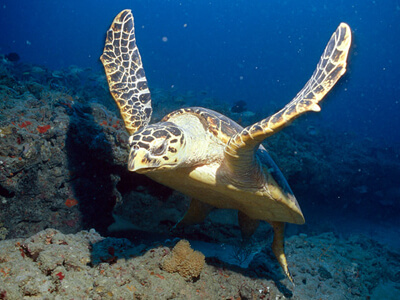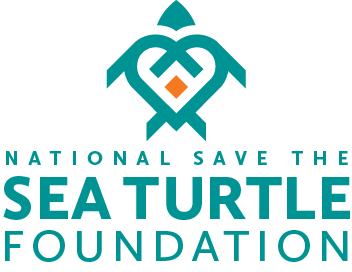Hawksbill Sea Turtles Fast Facts
Type: Reptile
Diet: Carnivore
Average life span in the wild: 30 to 50 years (est.)
Size: 24 to 45 in (62.5 to 114 cm)
Weight: 100 to 150 lbs (45 to 68 kg)
Protection status: Endangered
Size relative to a 6-ft (2-m) man:

Did you know?
Young hawksbill turtles are unable to dive deep and spend their early years floating amongst sea plants near the water’s surface.
Hawksbill turtles are found throughout the tropical waters of the Atlantic, Pacific, and Indian Oceans. They avoid deep waters, preferring coastlines where sponges are abundant and sandy nesting sites are within reach.
Not particularly large compared with other sea turtles, hawksbills grow up to about 45 inches (114 centimeters) in shell length and 150 pounds (68 kilograms) in weight. While young, their carapace, or upper shell, is heart-shaped, and as they mature it elongates. Their strikingly colored carapace is serrated and has overlapping scutes, or thick bony plates. Their tapered heads end in a sharp point resembling a bird’s beak, hence their name. A further distinctive feature is a pair of claws adorning each flipper. Male hawksbills have longer claws, thicker tails, and somewhat brighter coloring than females.
They are normally found near reefs rich in the sponges they like to feed on. Hawksbills are omnivorous and will also eat mollusks, marine algae, crustaceans, sea urchins, fish, and jellyfish. Their hard shells protect them from many predators, but they still fall prey to large fish, sharks, crocodiles, octopuses, and humans.
Like other sea turtles, hawksbills make incredible migrations in order to move from feeding sites to nesting grounds, normally on tropical beaches. Mating occurs every two to three years and normally takes place in shallow waters close to the shore. The nesting procedure begins when the turtles leave the sea to choose an area to lay their eggs. A pit is dug in the sand, filled with eggs, and then covered. At this stage the turtles retreat to the sea, leaving the eggs, which will hatch in about 60 days. The most dangerous time of their lives comes when hatchlings make the journey from their nests to the sea. Crabs and flocks of gulls voraciously prey on the young turtles during this short scamper.
Like many sea turtles, hawksbills are a critically endangered species due mostly to human impact. Hawksbill eggs are still eaten around the world despite the turtle’s international protected status, and they are often killed for their flesh and their stunning shells. These graceful sea turtles are also threatened by accidental capture in fishing nets.

